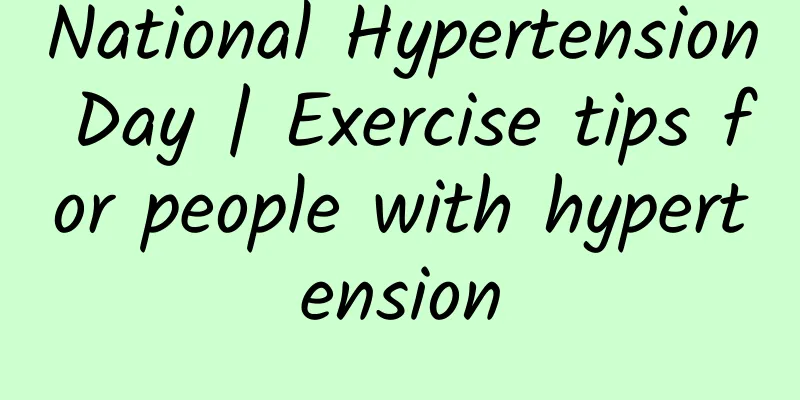National Hypertension Day | Exercise tips for people with hypertension

|
Although medication is an important part of hypertension management, lifestyle changes, especially exercise, are also important means of controlling hypertension. So, how should patients with hypertension exercise? What are the specific exercise treatment plans and precautions? Below, we will introduce you in detail. 01 1. A large number of studies have shown that moderate-intensity exercise lasting 30-45 minutes or more can reduce systolic blood pressure by 5-17 mmHg and diastolic blood pressure by 2-10 mmHg. It is recommended that patients perform moderate-intensity whole-body aerobic exercise 3-5 times a week for at least 150 minutes in total (i.e., heart rate reaches 40%-60% of heart rate reserve). We can also judge the intensity of exercise through the "conversation test". Moderate intensity means that you can still talk continuously during exercise. The exercise time is 30-60 minutes each time, which is adjusted according to physical condition and adaptability, which can help reduce weight, lower blood lipids, improve blood circulation, and reduce the burden on the heart. The basic components of an exercise session include warm-up, exercise content, finishing and relaxation, and stretching. Before starting, you can do a 6-minute walking test to understand whether the patient's cardiopulmonary function is suitable for intense exercise. The exercises that can be performed include: 1.1 Brisk walking: It is a low-intensity aerobic exercise that patients can do in the park, on a treadmill or outdoors. 1.2 Jogging: Suitable for patients with mild hypertension. It can be done in a safe place and keep a moderate speed. 1.3 Swimming: You can swim in freestyle, breaststroke or other swimming styles. 1.4 Cycling: You can ride outdoors or use indoor cycling equipment. 1.5 Low-impact aerobics: Patients can take aerobics classes or do low-impact dance moves at home. 02 2. Patients can perform moderate strength training on the basis of aerobic exercise. They should perform resistance training 2-3 days a week, 20-30 minutes each time. Training should be performed every other day. Moderate resistance training can improve muscle tension, increase muscle contraction, promote blood circulation, and improve peripheral vascular resistance, thereby helping to stabilize blood pressure and enhance cardiopulmonary function. The intensity of resistance training should be moderate. You can start with low intensity and gradually increase the exercise load to avoid excessive training that may lead to muscle strain or increased blood pressure. When performing resistance exercise, pay attention to breathing coordination, avoid holding your breath, and avoid increased blood pressure and increased cardiovascular risk. The exercises that can be performed include dumbbell and elastic band training. You can use the above tools to perform dumbbell bench press, squats, shoulder press, rowing and other exercises to improve muscle strength and endurance. However, not all hypertensive patients can perform the above-intensity exercise. Contraindications to exercise include uncontrolled severe hypertension (systolic blood pressure ≥ 180 mmHg or diastolic blood pressure ≥ 110 mmHg), acute complications such as hypertensive crisis, cardiovascular complications such as angina pectoris, acute myocardial infarction, severe diabetes, renal failure and other serious diseases. When moderate-intensity aerobic and resistance exercise cannot be completed weekly due to chronic diseases, physical activities should be performed as much as possible, such as walking on flat ground. Note: In order to ensure the safety of training, the heart rate needs to be controlled within an appropriate range, and the maximum heart rate during exercise should be controlled within (220-age)*(60%-75%). When patients are taking vasodilators and other drugs to lower blood pressure, they should increase the time for relaxation and pay attention to changes in blood pressure to avoid a rapid drop. During exercise, you should closely monitor your heart rate and blood pressure changes. If you experience dizziness, chest tightness, shortness of breath, or systolic blood pressure is too high or drops by more than 10mmHg, you should stop exercising and seek medical attention in time. References and Guidelines 1. Guidelines for the prevention and treatment of hypertension in China (revised version 2020); 2. 2020 European Society of Cardiology/Society of Hypertension (ESC/ESH) Guidelines for the Management of Hypertension; 3. American Heart Association (AHA) consensus on exercise and hypertension; 4. James E. Sharman, Andre La Gerche, Jeff S. Coombes, Exercise and Cardiovascular Risk in Patients With Hypertension, American Journal of Hypertension, Volume 28, Issue 2, February 2015, Pages 147–158, https://doi.org/10.1093/ajh/hpu191. END Name: Huang Junni, Shanghai Pudong Hospital Reviewer: Shen Xiafeng, Chief Physician, Director of Rehabilitation Department, Shanghai Pudong Hospital, Executive Editor of the Science Popularization Working Committee of the Chinese Rehabilitation Medicine Association: Jia Jing (Xinhua Hospital Affiliated to Shanghai Jiaotong University School of Medicine) |
<<: National Hypertension Day | Hypertension in children - a health hazard that cannot be ignored
>>: What impact will different puncture positions have on cesarean section anesthesia?
Recommend
Can women eat maca?
Of course women can eat maca, and if women take m...
Why is it itchy and smelly down there ten days after giving birth?
The most embarrassing thing in the world is to su...
The discharge is bloody but not bleeding
We all know that women are very susceptible to in...
Can I eat sugarcane when I have my period?
Menstruation is very painful for women and they f...
What medicine is effective for breast pain?
Breasts are a symbol of female gender and are res...
HPV vaccine is free in Jiangsu! Here are some things you need to know about HPV
Recently, there is good news. On December 21, an ...
Can I do moxibustion during menstruation?
Moxibustion is a very traditional treatment metho...
An article to teach you about mindfulness training
Author: Ren Feng Department of Psychiatry, Peking...
SamMobile: Samsung expects to cut mobile phone production by 30 million units in 2022
Recently, according to SamMobile, Samsung expects...
What should I eat less during my period to increase my menstrual flow?
Nowadays, many women have the problem of small me...
What is the reaction after the ring?
There will always be uncomfortable symptoms after...
Heart attack signs women need to know!
The magazine article published a summary of "...
The difference between lochia and menstruation
The lochia of pregnant women contains various flu...
How to measure your blood pressure correctly?
Author: Chen Zhou, Department of Nephrology, Shan...
What causes acute vulvitis?
Subacute vulvitis is a very common gynecological ...









